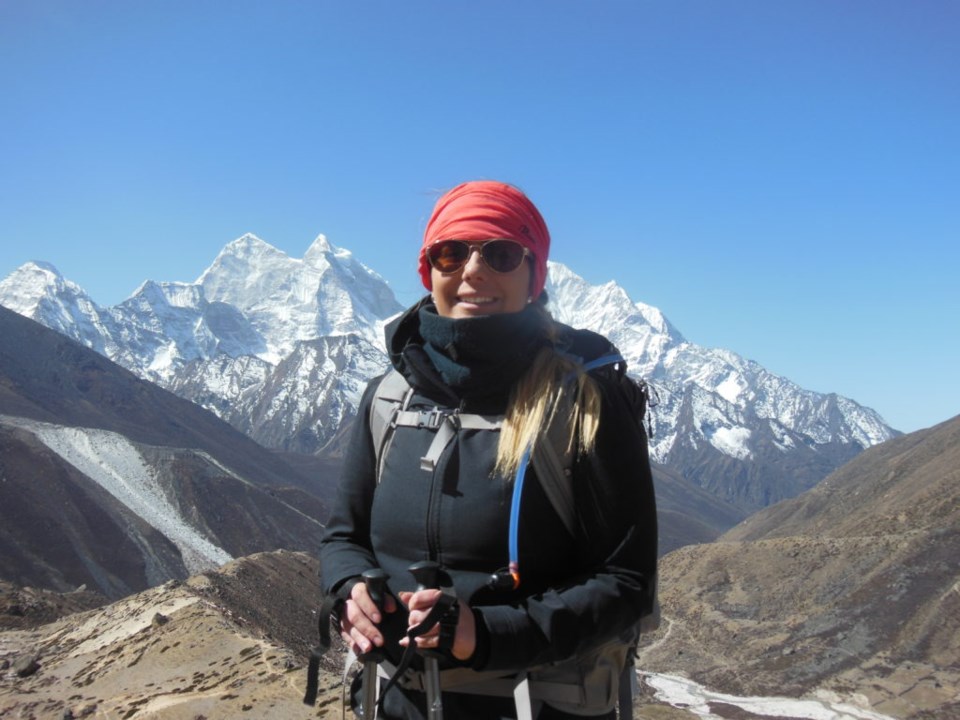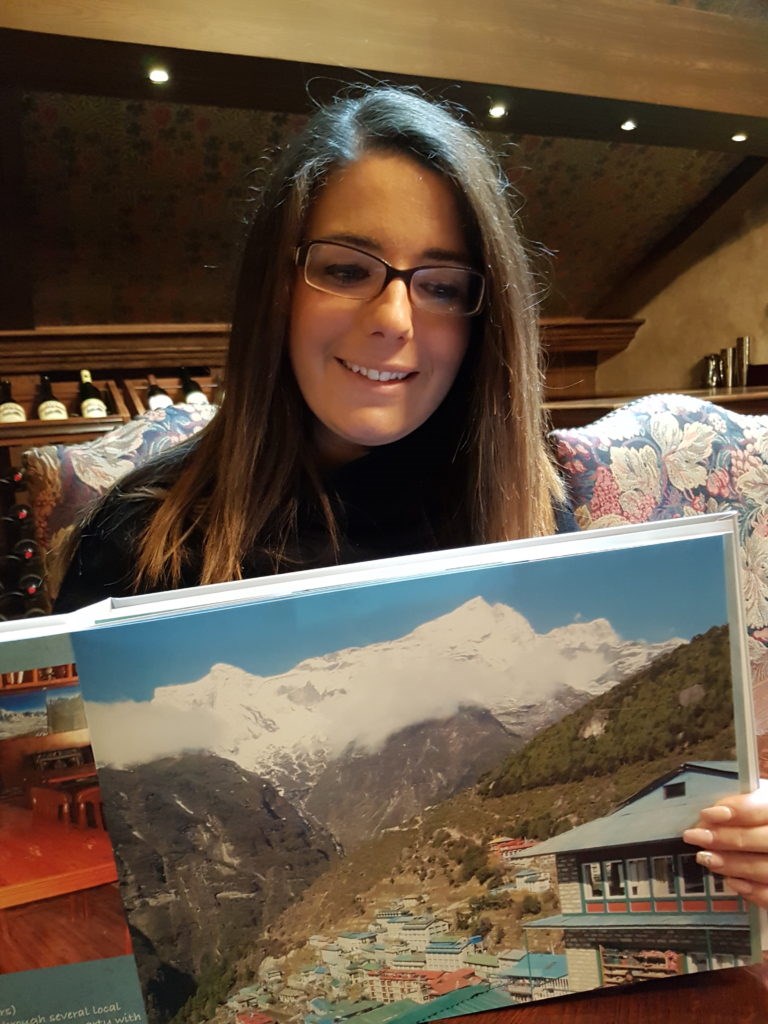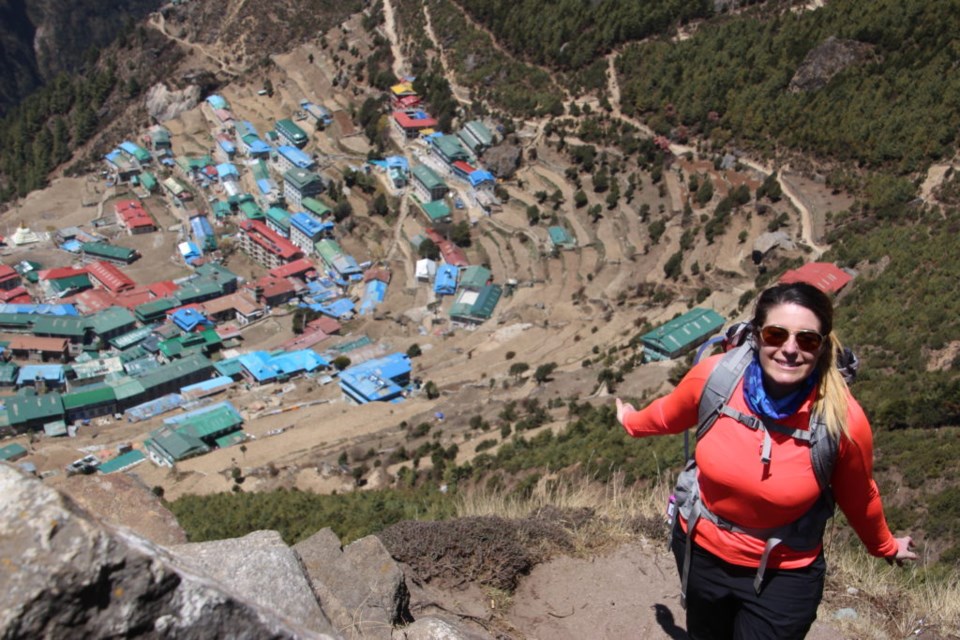
At least once a week, Kami McCallum turns the pages of her cherished, most recently-acquired photo album, reliving the memories of an adventure of a lifetime.
The 30-year-old Reif Winery assistant manager loves to travel, and chooses destinations off the beaten path — she prefers trips that challenge her.
Her most recent one will be hard to top.
As she was approaching her 30th birthday, she decided her next challenge would be a climb to Mount Everest base camp, at the foot of the world’s highest mountain.
“I had had zero experience in high altitudes, and I don’t even like camping. But I felt that going into my 30th year, I wanted to have something to train for, something to prepare me to be the best person I could be. Once I realized I wouldn’t have to climb Everest, that I could go to base camp, I knew I needed to do this. It was a goal that would really push my boundaries, mentally, physically and spiritually,” said McCallum. “I was on a journey of self-discovery, and this was going to be a defining moment.”
The year of training leading up to the climb was to be a huge part of that journey, she says.
The trip was booked May 5, 2017, with a departure date of May 3, 2018. McCallum was joined by her aunt, whom she describes as an adventurer, an athlete who also loves to be challenged, and who was approaching her 50th birthday. The two-week climb fit in nicely between the two milestone celebrations.
“There was no one else I could have done this with. I knew she was the one to go with me,” says McCallum. “She is someone who is always pushing her limits.”
For her aunt to have her husband accept her joining McCallum, she had to promise she wouldn’t come home determined to climb to the top — that was considered a real possibility, said McCallum. “She’s travelled the world. My uncle was terrified it would spark her mountain-climbing career again. In her younger years she would have climbed to the top.”
The trip even to base camp is not for the faint of heart. No matter how hard you train, or how fit you are, there is no way to predict how the high altitude will affect you, she learned.
But she prepared herself as best she could. Living and working on the Niagara River Parkway, she began walking a 17-kilometre stretch of the recreational trail three times a week, with weights of 30 to 50 pounds in a backpack. And every single kilometre, she would stop to do 50 squats.
“That’s more than 500 squats, three times a week,” she says.
“The first time, I just about puked. But I had music to listen to, and motivational podcasts that helped. The music was a bit of everything and anything.”
“Ain’t No Mountain High Enough” was one of her favourite songs, as well as “I Would Walk 500 Miles,” she says.
She also listened to Petit Biscuit, a French DJ and music producer, whose style she found uplifting, and without lyrics, gave her time to think.
She had also just started to work at Reif.
“I told Klaus (Reif, the winery owner) I was going to need two weeks off. He was so excited for me. To start a new job and start this journey at the same time — I look back on that time and I couldn’t be happier about the way it all worked out.”
To train, McCallum walked in all kinds of weather, and on Boxing Day 2017, she and her aunt went for a two-hour hike in -26 degrees Celsius to make sure the gear they had purchased would keep them warm. It did. The next test was to see if they were physically ready. In April, about a month before their departure, they signed up to climb 1,776 steps to the top of the CN Tower in Toronto — a fundraiser for the World Wildlife Foundation. It took them 20 minutes. They felt strong; good to go.
The flight into the airport in Nepal was the first terrifying encounter, she says. “You fly into Lukla, the world’s deadliest airport. There is this tiny, 1,600-foot runway, with a 2,000-foot cliff at one end and a wall at the other, and clouds hanging over the mountain, reducing the visibility. In or out it’s dangerous, but we made it.”
The first day ended at a tea house — similar to a hostel — in Namche, the staging point for the climb. “It was the cutest little village. It really reminded me of Niagara-on-the-Lake,” she said. There were interesting little shops — it’s famous for its bazaar —“and even a Baskin Robbins — that was our reward.”
There was also an Irish pub, she said, but drinking was not a great idea at that altitude — although it was a stop for a celebration on the way back down.
McCallum and her aunt were part of a group of 10, with two guides. There were other groups also climbing during the same period whom they would see off and on, and they didn’t realize until their climb had been completed safely and they were ready to return home, that three people had died in that same two-week window they were climbing.
They had seen one man “in shocking condition,” being carried on a horse and still heading up to the next stop, where he could receive medical attention. It was a day near the end of the trip when the visibility was so poor a helicopter couldn’t make it in to take him off the mountain.
“He didn’t make it,” she says. “On our way home we heard of two others who also died, and realized how really dangerous it had been. We were so lucky we had the guide we did. You can build up muscle in training, but you don’t know how your body is going to react to altitude sickness until you’re in that situation. Even if you have trained at high altitudes and been fine, that’s no guarantee it won’t happen — it can affect you at any point. It’s terrifying to think you could train for a year, and put your whole heart into it, but then come up against something that’s out of your control.”
That’s part of the danger, she says — climbers have worked so hard to get there and are so determined to complete the journey, they can’t turn back. “That’s why people die. You need a guide to understand that and turn you back if it’s too dangerous to continue.”
“Believe it or not,” she says, “there is Wi-Fi along the route, and you can call for a helicopter if you need to, with the exception of bad-weather days. There is no controlling that.”
The first day of the trip, she recalls, climbers are quickly lulled into a false sense of “this is easy, I’ve totally got this.” They start out actually trekking downhill for a bit, before the hike becomes a steep climb upwards. “You feel so confident,” she says.
You start at 8,700 feet above sea level, on the way to 17,000 feet. But after a “brutal, steep climb on a seven-hour hike, all up, you ask yourself, ‘what have I done,’ and you’ve still got this huge climb ahead of you.”
In addition to the altitude, the other factor that prevents climbers from finishing is food poisoning, she says. People are warned not to eat the meat that is transported by yaks, which is not properly refrigerated along the trek, so McCallum existed mostly on a diet of potatoes — mashed, roasted, pan-fried and delicious, fresh, hand-cut French fries. Add to that lots of rice, scrambled eggs, French toast, nak (the female yak) milk and cheese, and she had enough to eat to sustain her, although she lost 13 pounds. “The cheese was pretty awful. It tasted like Swiss cheese, and that’s not my favourite. We also brought our own protein bars, and that helped.”
McCallum became the DJ of the group with her playlist — she would make sure it was loud enough for everyone to hear, and it became a motivator for them all, she says. “Even the people in the other groups loved it. I was so glad to have it.”
The group of 10 became a family, looking out for each other, and they continue to keep in touch. “We shared such a great experience, and had such great camaraderie. We always felt we had each other’s backs. We started as a team and finished as a team,” she says.
During the day, while climbing, she says, “you get into your thoughts, and you tend to look down at your feet. Then you look up, and you remember why you’re there. The views were so incredibly stunning.”
Each day ended in a small Sherpa village, where the climbers slept in tea houses, basic structures that had heated communal space, but unheated sleeping quarters. “The higher you climbed the colder it got — down to about -10 degrees Celsius at night.”
Once they reached base camp, she says, “it feels like you’re standing at the bottom of the top of the world. Looking up to the top of Everest, it’s hard to believe people could climb so high.”
Thinking about that now, back at the winery with a job she loves, she says she feels humbled, and very fortunate to have reached her goal.
“I feel like I can do anything now. I still can’t believe I did it. To have accomplished something like this is life-changing.”
There was a morning after she returned from her trip, back at work at Reif, when she was called to the tasting bar. There were some women there she had met before the trip, and they had chatted about her plans.
They’d asked for her on their return — they wanted to hear about her adventure.
“Telling them some of my stories was so much fun. There are so many great stories to share. I tell everyone about that village, Namche, that reminded me so much of Niagara-on-the-Lake and home, and how comforting it was to be there.”
One story that is not so great, McCallum recalls, is how sick she was the last day of the climb. She woke up feeling like she had an elephant sitting on her chest. Her heart rate, which was supposed to be 74 to 76 beats per minute, was 108. The difficulty breathing she was experiencing made her fear she would not be going any further, and she wept to think she was so close, but would not finish. “I thought I was done,” she says.
But fortunately her guide had a different prognosis — he gripped her shoulders, looked her in the eyes and told her, “‘Crying is for the weak. You are not weak.’ My oxygen level was low, but above the cut-off level.”
Her aunt had an inhaler for asthma, and she borrowed that, which helped, before setting off on their final climb.
“I would have been devastated if I hadn’t made it,” she says.
Instead, she has an incredible feeling of accomplishment that has changed her, that will stay with her forever.
“If I have a bad day because of some little thing that might have bothered me before, it doesn’t bother me now. I remind myself, ‘there ain’t no mountain high enough.’ I’ve done some pretty cool things in my life — swimming with sharks, glacier-climbing in Iceland — but nothing like this. I would recommend it to others, but only under certain conditions. It’s definitely not for everyone.”
Why the attraction to climb Everest, even to the base camp?
“Because it’s there,” said McCallum. “Because you can. I’d love to do it again."

